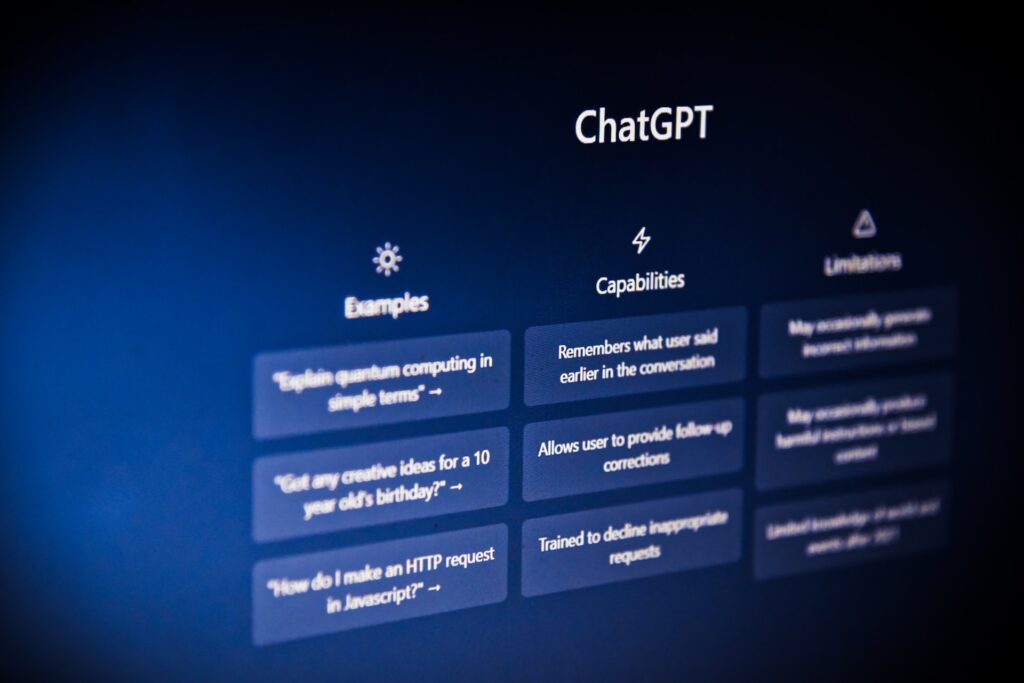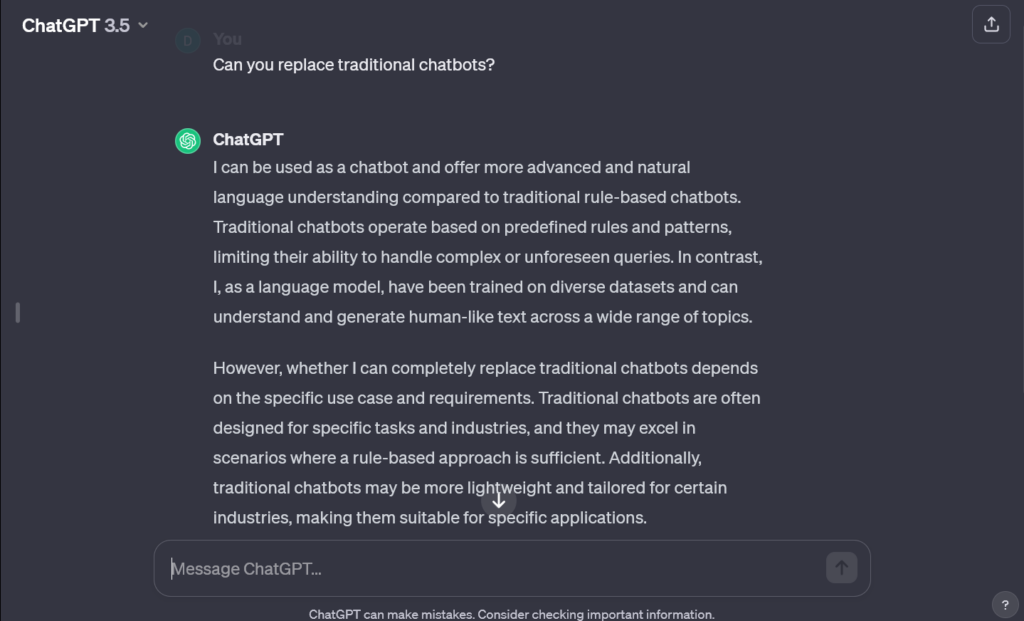What purposes do chatbots on various websites serve?
Providing good customer service is not a choice anymore. 9 out of 10 Americans rely on service to decide whether they want to buy from a business. Naturally, providing stellar customer service is not only essential for profitability but also to survive the competition.
However, excelling at customer experiences doesn’t always need a huge investment and a team of customer representatives. A chatbot can help you provide amazing customer experiences at a fraction of the cost.
We are familiar with chatbots on online stores and websites. They allowed businesses for years to engage and assist buyers.
Today, technologies like artificial intelligence (AI) and natural language processing (NLP) are transforming the chatbot realm. They are becoming more like humans with amazing capabilities to perform various tasks.
Let’s explore the use cases of traditional chatbots and what they made possible. Next, we will discuss how technologies like GPT and tools like ChatGPT are transforming the industry.
Automate Support Around the Clock
A chatbot is a virtual assistant driven by artificial intelligence. AI virtual assistants are now a part of our daily life and help us live better. You are interacting with an audio chatbot when you ask Siri or Alexa about the weather.
In the same way, you can set up a bot to chat with your customers on your website. A chatbot can use AI and machine learning to converse just like a human and provide support. You can program them to answer queries, link to resources, and more.
Best of all, you don’t need a person to stay up till 3 am to resolve customer queries. Chatbots are software and can run without supervision 24/7 once you program them.
That means you can provide support any time and create more loyal customers. Businesses in service like plumbers, painters, repairers, or even travel agencies can use chatbots to serve their customers automatically.
Expedia, Booking.com — everyone now uses a chatbot for 24/7 customer service and support.
Serve Knowledgebase and Resources

Chatbots are excellent at troubleshooting. You can use a chatbot to help your customers resolve common issues and understand features. Chatbots can ask your customers relevant questions and then point them towards the right resource.
You can program your bot to show videos, connect to knowledgebase, redirect to blogs and articles, and more. Industries like tech, finance, telecom, and similar businesses can reduce costs and eliminate the need for human support teams by using a chatbot.
Additionally, allowing your customers to resolve issues themselves can boost satisfaction. Statistics show 50% of millennials perceive self-service as an integral part of a brand promise.
Top names in retail like Taco Bell and Burger King have already shifted to chatbots. You can, too, install a chatbot and serve your customers best to gain a competitive edge.
Chatbots Engage Customers Better
Engaging your leads is a great way to boost conversions. For that, you need to nurture your web visitors and encourage them to take action. However, you can’t push them too much to click the buy button!
The trick is to build a rapport with your visitors and help them make the purchasing decision. You will find many opportunities to assist and nurture your customers by doing a bit of research.
For example, over 50% of shoppers will quit immediately if they cannot access assistance while shopping online. Or, 57% of shoppers refrain from buying due to lack of information.
Chatbots can come in handy in such situations to assist and engage customers. If you succeed in satisfying the quench for information, your visitors will turn into your paying customers.
It’s no wonder 74% of global businesses prioritize lead nurturing. Not only can you improve your conversions, but you also provide a fantastic shopping experience to your customers.
Many industries like eCommerce use chatbots to nurture customers. Spring is one such name that relies on chatbots to drive customer engagement and provide the ultimate shopping pleasure.
No matter the industry, your chatbot is a cost-effective way to nurture clients and boost sales. Additionally, engaged customers are more loyal and self-advocates of a brand to aid in your marketing.
Serve Customer Needs Autonomously
The on-demand economy has removed the concept of traditional operating hours. Now, your customers may come any time during the night or day. However, if they find your shop closed, they may never return.
For some businesses, operating hours are now a restriction. A small clinic may lose out on its customers to a hospital that charges more but entertains 24/7 appointment booking. Anyone can call the hospital, even at 3 am and get all information about available doctors.
However, being a small business, you can’t afford to pay salaries for two shifts to take calls at 3 am.
As you’ve guessed, a chatbot is ideal in such situations. You will not need a person to handle calls and answer customer queries beyond your working hours. Your chatbot can give the list of available doctors, their timings, and even help patients to book the appointment.
Everything happens automatically without any human involvement.
Similarly, you can use your chatbot to generate business 24/7 by enabling bookings, reservations, and ordering.
Personalize Your Service
Personalization is the key to business success. 75% of online consumers go for brands that provide personalized offers and content. Additionally, 74% of shoppers end up getting frustrated if the content is not relevant to them.
You can gauge the need for personalization in the case of industries like finance. A person will only be interested in products that align with their financial status and goals. Recommending the wrong thing will surely make them frustrated.
Chatbots are affordable ways to provide personalized service. In fact, chatbots are now popular as personal finance advisors, helping people navigate the maze of loans and investments.
Many industries take the help of AI-driven chatbots to woo customers, like fashion and clothing. H&M, Sephora, and other top brands use chatbots for personal recommendations. . You can also personalize your service and recommend the right products for assured conversions.
Your customers will be happier and choose you over your competitors because of your approach.
Chatbots Add a Human Touch
Your customers don’t like to view themselves as an order number or a support ticket. They want to be treated like a human and shown respect and care. Statistics also prove that 84% of consumers are more likely to be repeat customers if customer support treats them like a human.
Chatbots are not humans but can mimic human conversations efficiently. They can deliver a context-based service and address customers by their name. Today, chatbot technology has become so advanced that bots can write a detailed, thoughtful response like a human instantly.
Additionally, a chatbot can learn from chats and improve to even replace a human agent. That means you can add a human touch to your service without the cost of hiring a human! Isn’t that great?
The Coming of ChatGPT

ChatGPT has created a buzz all around the world. From content creators to companies, everyone is capitalizing on the features of the tool.
Even students are using ChatGPT to write their assignments and get an A+! You provide a prompt, and it can reply with an answer or even write a potential blog.
ChatGPT is based on GPT-3, a transformative machine learning model.
What is GPT-3?
GPT-3 is short for Generative Pre-trained Transformer 3. It is an advanced AI language model developed by OpenAI. The company is also behind the creation of ChatGPT.
GPT-3 is the third iteration of the GPT series, and each version builds upon the advancements of its predecessors.
The language model is popular for its expansive capabilities. It is made of 175 billion parameters – the largest of its kind.
Parameters are adjustable values that the model picks up during training. The high parameter count allows GPT-3 to provide relevant and coherent replies on a broad range of topics.
GPT-3 relies on a transformer architecture, a deep learning model. It is designed specifically for processing natural language and capturing complex patterns.
Most importantly, it can generate human-like text – a prerequisite for developing a chatbot.
GPT-3.5
GPT-3.5 is an improved version of its predecessor. It comes with the same number of parameters as GPT-3.
However, the model provides better answers due to the refinement of human feedback. It filters out irrelevant or bad replies and provides optimized versions.
GPT-3.5 replies are more accurate, helpful, and creative.
GPT-4
GPT-4 is the latest iteration of GPT. It is also the most accurate and creative. The model has learned to reply with natural and responsible answers.
Most importantly, the multilingual capability of the model has increased. Moreover, GPT-4 understands text and image inputs. You can provide visual elements in your prompts, such as graphs and charts.
However, the program cannot reply in images.
Below are the primary differences between GPT-3.5 and 4:
| GPT-3.5 | GPT-4 |
| 175 billion parameters | 100 trillion parameters |
| Supports only text | Supports text and image |
| 1,500 – 3,000 words limit | 25,000 words limit |
Additionally, GPT-4:
- Is 82% less likely to respond to inappropriate requests
- Is 40% more likely to provide factual replies
- Can adjust responses based on emotions in text
- Generates different dialects
- Synthesizes information from multiple sources
- Provides comprehensive and nuanced responses
- Cites sources and research
- Can solve complex scientific or mathematical problems
- Write code and debug more efficiently
What is ChatGPT?

ChatGPT refers to Chat Generative Pre-trained Transformer. ChatGPT-4 is the latest version built on GPT-4.
ChatGPT is also an AI language model and excels in natural language conversations. It provides responses and generates replies based on the input.
The whole thing works just like a chat window.
OpenAI trained ChatGPT on a wide range of internet text sources to develop a broad understanding of language and knowledge. It uses deep learning techniques to capture and generate human-like text.
ChatGPT can understand and reply in various languages. It can assist with several tasks, such as:
- Answering questions
- Generating responses
- Online researching
- Providing explanations
- Conversing on diverse topics
ChatGPT is more creative and generates more human-like text compared to traditional chatbots. It can even hold a conversation for longer without losing connection or context.
However, can ChatGPT mean an end to traditional chatbots? To answer that, let’s first find out how ChatGPT differs from chatbots.
ChatGPT vs. Traditional Chatbots: The Primary Differences
ChatGPT has many features lacking in traditional chatbots. Some are:
- RLHF (Reinforcement Learning with Human Feedback): It combines reinforcement learning and human feedback to enhance the training process. The language model can act and decide with guidance from prompt writers.
- Free and user-friendly: ChatGPT is simple and easy to use. Anyone can have a conversation, like chatting with another person.
- Fantastic user experience: OpenAI streamlined the user experience so that ChatGPT can hold conversations for a while. It can do a lot more than generating short lines of text.
Additionally, ChatGPT differs from traditional chatbots in the following ways:
Better Language Capabilities
ChatGPT can have human-like conversations in natural language. In comparison, rule-based chatbots can only reply with a programmed chain of responses.
They work on an if-this-then rule-based system to generate responses. As a result, you cannot expect replies in natural language.
AI chatbots incorporate natural language processing (NLP) and machine learning elements. They are able to have a conversation on limited topics programmed by the business.
Most websites use an AI chatbot with NLP today.
ChatGPT is in its own league. It has no qualms about holding a conversation on any topic you provide. Moreover, it can remember context and create fitting responses.
RLHF is the secret behind ChatGPT’s human-like conversing capabilities. The developers fine-tuned the initial model through human AI trainers.
These experts trained the model as a prompter and an AI assistant. Moreover, the trainers relied on model-written suggestions to develop improved responses.
The developers combined this conversational database with the tool’s dataset to create an outstanding dialogue format.
We asked ChatGPT how it was different in natural language capabilities from older chatbots. It provided the following response:
Better Learning Capabilities
Earlier, traditional chatbots relied on rule-based systems. Later, AI chatbots with natural language processing skills came to the market.
However, ChatGPT stands out from even the latest AI business chatbots. The main reasons are the GPT-3.5 model and deep learning mechanisms.
We can attribute the advanced learning capabilities of ChatGPT to:
Neural Network Architecture
ChatGPT’s underlying architecture is a transformer-based neural network. Transformers are designed to process sequential data like language in a highly parallel and scalable manner.
This architecture allows ChatGPT to understand the context of a conversation. It can also learn patterns and relationships in the data more effectively.
Pre-Training on Vast Amount of Data
Developers pre-trained ChatGPT on an enormous dataset containing a diverse range of text. This approach exposed the model to a vast array of language patterns, syntax, and semantics.
Most importantly, it helped ChatGPT learn grammar, sentence structures, and complex reasoning.
Transfer Learning
ChatGPT can perform transfer learning. It can leverage the knowledge gained during pre-training to adapt and fine-tune itself. Therefore, you can get relevant and custom responses on specific tasks or domains with smaller datasets.
The learning approach allows ChatGPT to specialize in various tasks while retaining a general language understanding.
Continuous Learning
ChatGPT can continually learn from new data and conversations. Each interaction provides the opportunity to gather valuable information and update the tool’s understanding of language and the world.
The ability to learn from real-world interactions makes ChatGPT a dynamic and ever-relevant solution.
Contextual Understanding
ChatGPT uses deep learning models to consider context and understand relationships between words and sentences.
Therefore, the tool can respond in a more contextually relevant and coherent manner.
Less Fine Tuning
Unlike traditional chatbots, ChatGPT generates responses based on patterns learned during training. Therefore, it can handle a vast range of inputs without explicit programming.
Additionally, the approach makes the language model more versatile.
Generalization

ChatGPT can use its training to respond accurately to new prompts. It learned from the examples during training to learn to generalize.
This capability allows the tool to handle new and diverse conversational scenarios.
Better Adaptability
ChatGPT is more adaptable compared to traditional and AI chatbots. We already discussed some factors that make it possible, like:
- Continuous learning
- Understanding context
- Generalization
However, there are more factors that make the language model adapt to new and unexpected scenarios. Some of them are:
Understanding Nuances
ChatGPT’s natural language processing allows it to understand complex sentence structures. It can also identify subtle nuances in conversations.
The sophisticated model lets it tailor its responses to meet changing requirements and inputs.
Fits Diverse Scenarios
Traditional chatbots often rely on predefined responses or rule-based systems. It limits their ability to adapt to new or unforeseen user inputs.
In contrast, ChatGPT generates responses based on patterns learned during training, allowing more diverse and adaptable replies.
Handling Ambiguity
Human communication often includes vague or imprecise expressions. ChatGPT is designed to handle ambiguity in language and interpret such inputs.
Therefore, the tool can create more accurate and contextually appropriate responses.
Less Reliance on Rules
Traditional chatbots rely heavily on rules and programmed responses. It limits their adaptability and prevents them from handling diverse conversations.
ChatGPT is a language model that relies on patterns learned from extensive training data. The model can adapt to various conversation styles and topics without explicit programming.
Handling Multiple Topics
ChatGPT can seamlessly switch between different topics within the same conversation, providing relevant answers for each. This ability to multitask and adapt to various topics contributes to a more engaging and dynamic conversational experience.
Better Intent Discovery
Intent discovery refers to understanding the user’s purpose or intention behind a given query or statement. ChatGPT is an AI language model designed to discover intent, which older chatbots struggle with.
Several reasons make ChatGPT better at intent discovery, such as:
- Contextual understanding
- Transfer learning
- Handling ambiguity
- Generalization
- Continuous learning
Additionally, ChatGPT is a pro at intent discovery due to its:
Natural Language Understanding (NLU)
Traditional chatbots often use rule-based or keyword-matching techniques to determine user intent. These methods can be limited and may not effectively handle complex language patterns or nuances.
In comparison, ChatGPT utilizes advanced deep learning techniques, such as transformer-based neural networks. It allows the tool to understand natural language more comprehensively.
Its architecture helps the model to capture intricate relationships and context within the user’s input, enabling more accurate intent discovery.
Multifaceted Intent Recognition
ChatGPT’s capacity to understand context and relationships allows it to recognize more complex intents with multiple layers of meaning.
The tool can grasp implicit intents and respond accordingly for more human-like conversations.
All of the above capabilities make ChatGPT a versatile option for countless industries. You may apply it to several domains, such as customer support, education, entertainment, content generation, and more.
However, can the language model make older solutions obsolete? Let’s explore.
Can ChatGPT Replace Traditional Business Chatbots?

We asked ChatGPT if it was good enough to replace existing business chatbots. ChatGPT was confident on many grounds that we covered above, including:
- Improved language capabilities
- Enhances learning capabilities
- Flexibility and adaptability
However, the tool raised some factors to consider before wiping out chatbots:
- Custom use cases: An AI language model may not have the domain-specific knowledge of a business. It may be a challenge to customize ChatGPT for particular industries.
- Data privacy: An external program may bring in privacy and security concerns. Sensitive data like customer information can leave the business premises.
- Personalization: Achieving custom branding may be challenging with a language model. Chatbots may better capture a business’s tone, messaging, and voice.
- Integration: Replacing existing infrastructure and implementing a new model may be laborious and challenging for some organizations.
- Cost: API usage and related costs may add up to more than running a traditional chatbot.
GPT-4 resolves many of the concerns above. Developers can use the GPT-4 API to create custom chatbots for businesses. The latest iteration is more accurate and provides reliable responses with negligible errors.
Moreover, programmers can define how the model should respond to queries and inputs. They can give it a custom voice to match the branding of the company.
Businesses can access GPT-4 API at competitive pricing models. OpenAI offers several plans and a pay-as-you-go system to maximize its capabilities.
So, can we say ChatGPT may replace chatbots?
The decision is yet to be made. However, many organizations are trying their hands on GPT to build products and virtual assistants.
Let’s take the example of Khan Academy, a non-profit educational organization. It is running a pilot program based on GPT-4 to power Khanmigo.
It is an AI-powered assistant that acts as a virtual tutor for students and a virtual assistant for teachers. Students can get guidance on lessons and helpful prompts to learn at their own pace and style.
The program can also guide teachers to teach better. It can point to resources and provide information to improve learning outcomes.
Source: https://openai.com/customer-stories/khan-academy
Khan Academy is getting recommendable results from Khanmigo. It shows that businesses can adopt AI language models and build custom chatbots.
Final Thoughts
Chatbots serve a vital role for businesses. ChatGPT holds the potential to transform existing chatbots for better responses and engagement. Developers can fine-tune the model to a business’s branding for personalized messaging.
A combination of AI language model and chatbot technology is apt for meeting business requirements. GPT-4 makes this possible and opens the doors for more natural and human-like messaging from brands.
We can help you build custom chatbots using GPT-4 to engage your customers and audience. You can achieve your branding and tone to click with your buyers instantly. Get in touch with us to learn more about how we can help.
